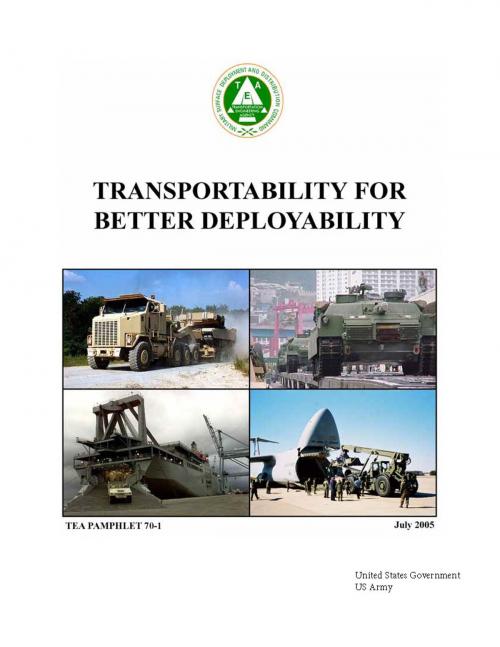Transportability for Better Deployability TEA Pamphlet 70-1 July 2005
Nonfiction, Science & Nature, Technology, Technical & Manufacturing Industries & Trades, Engineering, Automotive, Military Science| Author: | United States Government US Army | ISBN: | 1230000201363 |
| Publisher: | eBook Formatting Team | Publication: | December 7, 2013 |
| Imprint: | Language: | English |
| Author: | United States Government US Army |
| ISBN: | 1230000201363 |
| Publisher: | eBook Formatting Team |
| Publication: | December 7, 2013 |
| Imprint: | |
| Language: | English |
Properly applied transportability engineering is essential to the deployment of military equipment. An item of equipment is of little value if it cannot be transported rapidly and efficiently to where it is needed. This publication is a guide to transportability. It is intended for everyone interested in transportability: decision makers, materiel developers, combat developers, equipment designers and users, logisticians, and transporters. It is not designed to make you an instant transportability expert, but to help you understand the Engineering for Transportability program and the various transport modes. Detailed transportability criteria are given in MIL-STD-1366. This pamphlet will explain how new or modified equipment can affect force deployability, show some examples of lessons learned from past deployments and exercises, as well as cover the following areas of transportability and deployability:
This pamphlet provides insight into the Engineering for Transportability program, transport modes and limitations, and the definition of a transportability problem item. It will answer the following questions:
What is transportability? Why is it important?
What are the limits and restrictions of the transportation infrastructure and assets? What qualifies as a transportability problem item?
This pamphlet explains how transportability fits into the materiel acquisition cycle. It will answer the following questions:
When should TEA become involved in a program?
How should transportability requirements be determined and how are they written? What is transportability approval, when is it required, and how is it obtained?
How can modeling and simulation be used during acquisition?
What types of tests are required?
Properly applied transportability engineering is essential to the deployment of military equipment. An item of equipment is of little value if it cannot be transported rapidly and efficiently to where it is needed. This publication is a guide to transportability. It is intended for everyone interested in transportability: decision makers, materiel developers, combat developers, equipment designers and users, logisticians, and transporters. It is not designed to make you an instant transportability expert, but to help you understand the Engineering for Transportability program and the various transport modes. Detailed transportability criteria are given in MIL-STD-1366. This pamphlet will explain how new or modified equipment can affect force deployability, show some examples of lessons learned from past deployments and exercises, as well as cover the following areas of transportability and deployability:
This pamphlet provides insight into the Engineering for Transportability program, transport modes and limitations, and the definition of a transportability problem item. It will answer the following questions:
What is transportability? Why is it important?
What are the limits and restrictions of the transportation infrastructure and assets? What qualifies as a transportability problem item?
This pamphlet explains how transportability fits into the materiel acquisition cycle. It will answer the following questions:
When should TEA become involved in a program?
How should transportability requirements be determined and how are they written? What is transportability approval, when is it required, and how is it obtained?
How can modeling and simulation be used during acquisition?
What types of tests are required?















